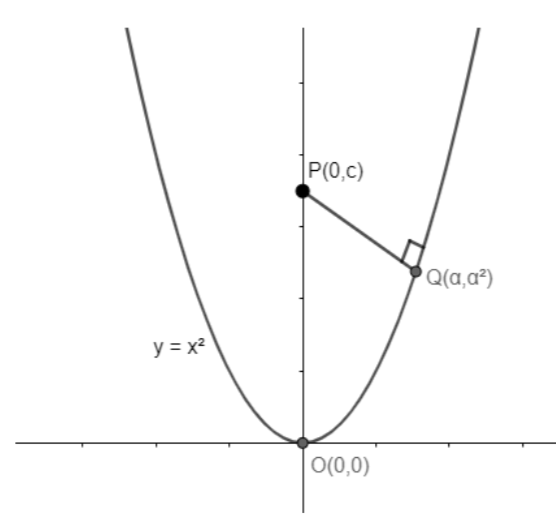
Answer
469.2k+ views
Hint: Draw the graph for the parabola \[y={{x}^{2}}\] with vertex at (0,0) and draw a normal from P (0,c) to the parabola. This normal will be the shortest distance between the point and the parabola. The best approach is using calculus we can find the slope of Normal.
Complete step-by-step solution:
The parabola \[y={{x}^{2}}\] is drawn below along with normal from P (0, c) to the parabola.

Let the normal intersect the parabola at \[Q\left( \alpha ,{{\alpha }^{2}} \right)\]. Hence, PQ will the shortest distance from point P to the parabola. We have to find the distance between point P and Q.
Finding the slope of normal drawn, we get,
\[y={{x}^{2}}\]
Differentiating both sides with respect to x, we get,
\[\Rightarrow \dfrac{dy}{dx}=2x\]
Now, at \[\dfrac{dy}{dx}\] at Q will give the slope of tangent,
\[\Rightarrow {{\left. \dfrac{dy}{dx} \right|}_{at\text{ }Q}}=2\alpha \]
Since the tangent and normal are perpendicular to each other, i.e., \[{{m}_{1}}{{m}_{2}}=-1\], hence, the slope of normal will be given by
\[{{m}_{1}}{{m}_{2}}=-1\]
\[\Rightarrow 2\alpha {{m}_{1}}=-1\]
$\Rightarrow {{m}_{1}}=\dfrac{-1}{2\alpha }$
Slope of Normal, \[m=-\dfrac{1}{2\alpha }...............(i)\]
Also, since we have coordinates of two points P and Q, so using the formula of two – point form to find the slope of normal.
The two – point form is given by the equation \[m=\dfrac{{{y}_{2}}-{{y}_{1}}}{{{x}_{2}}-{{x}_{1}}}................(ii)\]
From the given coordinates P (0, c) and \[Q\left( \alpha ,{{\alpha }^{2}} \right)\], we have,
\[{{x}_{1}}=0,{{y}_{1}}=c\]
\[{{x}_{2}}=\alpha ,{{y}_{2}}={{\alpha }^{2}}\]
Now, replacing the values of \[{{x}_{1}},{{y}_{1}},{{x}_{2}},{{y}_{2}}\] in equation (i), we get,
\[m=\dfrac{{{\alpha }^{2}}-c}{\alpha -0}..............(iii)\]
From equation (i) and (iii), we get,
\[-\dfrac{1}{2\alpha }=\dfrac{{{\alpha }^{2}}-c}{\alpha -0}\]
\[\Rightarrow -\dfrac{1}{2\alpha }=\dfrac{{{\alpha }^{2}}-c}{\alpha }\]
\[\Rightarrow -\dfrac{1}{2}={{\alpha }^{2}}-c\]
\[\Rightarrow {{\alpha }^{2}}-c=-\dfrac{1}{2}\]
\[\Rightarrow {{\alpha }^{2}}=c-\dfrac{1}{2}\]
\[\Rightarrow \alpha =\pm \sqrt{c-\dfrac{1}{2}}\]
Thus, the coordinates of point Q is \[\left( \pm \sqrt{c-\dfrac{1}{2}},c-\dfrac{1}{2} \right)\].
We know, the distance between the two points is given by the formula:
\[d=\sqrt{{{\left( {{x}_{2}}-{{x}_{1}} \right)}^{2}}+{{\left( {{y}_{2}}-{{y}_{1}} \right)}^{2}}}...............(iv)\]
Using the formula (iv) to find the distance between the point PQ, we get,
\[{{x}_{1}}=0,{{y}_{1}}=c\]
\[{{x}_{2}}=\pm \sqrt{c-\dfrac{1}{2}},{{y}_{2}}=c-\dfrac{1}{2}\]
Now, replacing the values of \[{{x}_{1}},{{y}_{1}},{{x}_{2}},{{y}_{2}}\] in equation (iv), we get,
\[PQ=\sqrt{{{\left( 0\mp \sqrt{c-\dfrac{1}{2}} \right)}^{2}}+{{\left( c-\dfrac{1}{2}-c \right)}^{2}}}\]
\[\Rightarrow PQ=\sqrt{{{\left( \mp \sqrt{c-\dfrac{1}{2}} \right)}^{2}}+{{\left( c-c-\dfrac{1}{2} \right)}^{2}}}\]
\[\Rightarrow PQ=\sqrt{\left( c-\dfrac{1}{2} \right)+{{\left( -\dfrac{1}{2} \right)}^{2}}}\]
\[\Rightarrow PQ=\sqrt{c-\dfrac{1}{2}+\dfrac{1}{4}}\]
\[\Rightarrow PQ=\sqrt{c-\dfrac{1}{4}}\]
\[\therefore PQ=\sqrt{\dfrac{4c-1}{4}}\]
Note: The best approach to solve this question is to make use of calculus. In order to find the shortest distance from a point to any geometric figure is to draw a normal from the point to the figure. Students must take care of the difference between the tangent and normal. There is a relation between the slopes of a tangent and normal, i.e., \[{{m}_{1}}{{m}_{2}}=-1\].
Complete step-by-step solution:
The parabola \[y={{x}^{2}}\] is drawn below along with normal from P (0, c) to the parabola.

Let the normal intersect the parabola at \[Q\left( \alpha ,{{\alpha }^{2}} \right)\]. Hence, PQ will the shortest distance from point P to the parabola. We have to find the distance between point P and Q.
Finding the slope of normal drawn, we get,
\[y={{x}^{2}}\]
Differentiating both sides with respect to x, we get,
\[\Rightarrow \dfrac{dy}{dx}=2x\]
Now, at \[\dfrac{dy}{dx}\] at Q will give the slope of tangent,
\[\Rightarrow {{\left. \dfrac{dy}{dx} \right|}_{at\text{ }Q}}=2\alpha \]
Since the tangent and normal are perpendicular to each other, i.e., \[{{m}_{1}}{{m}_{2}}=-1\], hence, the slope of normal will be given by
\[{{m}_{1}}{{m}_{2}}=-1\]
\[\Rightarrow 2\alpha {{m}_{1}}=-1\]
$\Rightarrow {{m}_{1}}=\dfrac{-1}{2\alpha }$
Slope of Normal, \[m=-\dfrac{1}{2\alpha }...............(i)\]
Also, since we have coordinates of two points P and Q, so using the formula of two – point form to find the slope of normal.
The two – point form is given by the equation \[m=\dfrac{{{y}_{2}}-{{y}_{1}}}{{{x}_{2}}-{{x}_{1}}}................(ii)\]
From the given coordinates P (0, c) and \[Q\left( \alpha ,{{\alpha }^{2}} \right)\], we have,
\[{{x}_{1}}=0,{{y}_{1}}=c\]
\[{{x}_{2}}=\alpha ,{{y}_{2}}={{\alpha }^{2}}\]
Now, replacing the values of \[{{x}_{1}},{{y}_{1}},{{x}_{2}},{{y}_{2}}\] in equation (i), we get,
\[m=\dfrac{{{\alpha }^{2}}-c}{\alpha -0}..............(iii)\]
From equation (i) and (iii), we get,
\[-\dfrac{1}{2\alpha }=\dfrac{{{\alpha }^{2}}-c}{\alpha -0}\]
\[\Rightarrow -\dfrac{1}{2\alpha }=\dfrac{{{\alpha }^{2}}-c}{\alpha }\]
\[\Rightarrow -\dfrac{1}{2}={{\alpha }^{2}}-c\]
\[\Rightarrow {{\alpha }^{2}}-c=-\dfrac{1}{2}\]
\[\Rightarrow {{\alpha }^{2}}=c-\dfrac{1}{2}\]
\[\Rightarrow \alpha =\pm \sqrt{c-\dfrac{1}{2}}\]
Thus, the coordinates of point Q is \[\left( \pm \sqrt{c-\dfrac{1}{2}},c-\dfrac{1}{2} \right)\].
We know, the distance between the two points is given by the formula:
\[d=\sqrt{{{\left( {{x}_{2}}-{{x}_{1}} \right)}^{2}}+{{\left( {{y}_{2}}-{{y}_{1}} \right)}^{2}}}...............(iv)\]
Using the formula (iv) to find the distance between the point PQ, we get,
\[{{x}_{1}}=0,{{y}_{1}}=c\]
\[{{x}_{2}}=\pm \sqrt{c-\dfrac{1}{2}},{{y}_{2}}=c-\dfrac{1}{2}\]
Now, replacing the values of \[{{x}_{1}},{{y}_{1}},{{x}_{2}},{{y}_{2}}\] in equation (iv), we get,
\[PQ=\sqrt{{{\left( 0\mp \sqrt{c-\dfrac{1}{2}} \right)}^{2}}+{{\left( c-\dfrac{1}{2}-c \right)}^{2}}}\]
\[\Rightarrow PQ=\sqrt{{{\left( \mp \sqrt{c-\dfrac{1}{2}} \right)}^{2}}+{{\left( c-c-\dfrac{1}{2} \right)}^{2}}}\]
\[\Rightarrow PQ=\sqrt{\left( c-\dfrac{1}{2} \right)+{{\left( -\dfrac{1}{2} \right)}^{2}}}\]
\[\Rightarrow PQ=\sqrt{c-\dfrac{1}{2}+\dfrac{1}{4}}\]
\[\Rightarrow PQ=\sqrt{c-\dfrac{1}{4}}\]
\[\therefore PQ=\sqrt{\dfrac{4c-1}{4}}\]
Note: The best approach to solve this question is to make use of calculus. In order to find the shortest distance from a point to any geometric figure is to draw a normal from the point to the figure. Students must take care of the difference between the tangent and normal. There is a relation between the slopes of a tangent and normal, i.e., \[{{m}_{1}}{{m}_{2}}=-1\].
Recently Updated Pages
A particle is undergoing a horizontal circle of radius class 11 physics CBSE

A particle is thrown vertically upwards with a velocity class 11 physics CBSE

A particle is rotated in a vertical circle by connecting class 11 physics CBSE

A particle is projected with a velocity v such that class 11 physics CBSE

A particle is projected with a velocity u making an class 11 physics CBSE

A particle is projected vertically upwards and it reaches class 11 physics CBSE

Trending doubts
Fill the blanks with the suitable prepositions 1 The class 9 english CBSE

Which are the Top 10 Largest Countries of the World?

How do you graph the function fx 4x class 9 maths CBSE

Who was the leader of the Bolshevik Party A Leon Trotsky class 9 social science CBSE

The Equation xxx + 2 is Satisfied when x is Equal to Class 10 Maths

Differentiate between homogeneous and heterogeneous class 12 chemistry CBSE

Difference between Prokaryotic cell and Eukaryotic class 11 biology CBSE

Which is the largest saltwater lake in India A Chilika class 8 social science CBSE

Ghatikas during the period of Satavahanas were aHospitals class 6 social science CBSE




